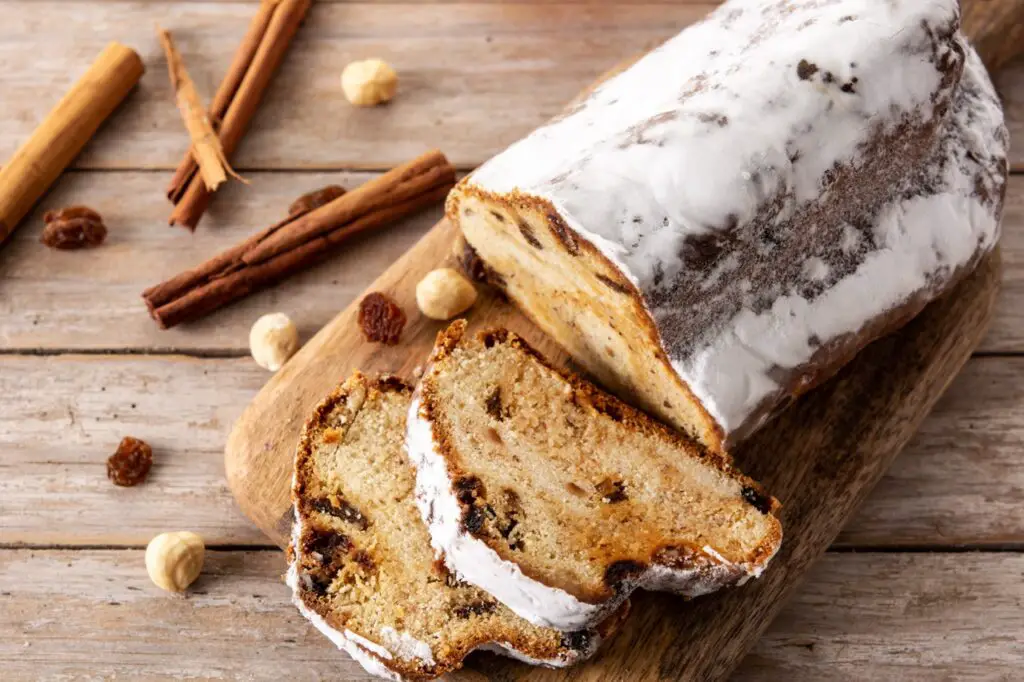Are you ready to embark on a delightful journey into the world of Stollen bread? This beloved holiday treat has a rich history, diverse variations, and a unique cultural significance. In this SEO-optimized article, we’ll delve into the heartwarming tale of Stollen bread, from its intriguing origins to its mouthwatering recipes. Along the way, we’ll also answer some frequently asked questions about this delectable delight.
Stollen bread, also known as Christstollen, is a cherished German Christmas tradition that has captured the hearts and taste buds of people worldwide. If you’re curious about its historical roots and cultural significance, let’s begin by exploring its fascinating history.
Historical Origins of Stollen Bread
Stollen bread traces its roots back to 15th-century Germany, with its first documented mention in 1329. Initially baked as a simple, unleavened bread during Advent, it evolved over time into the sweet, fruit-filled treat we know today. The name “Stollen” is believed to have been derived from the German word “Stolle,” meaning post or support, possibly referring to its shape resembling a wrapped bundle.
Key Ingredients and Directions of Stollen Bread
Print
Stollen Bread
Ingredients
- 2 ½ cups all-purpose flour
- 1 packet active dry yeast
- ¾ cup warm milk
- Pinch of salt
- 1 cup candied fruits
- ½ cup raisins
- 8 ounces marzipan
- ½ cup butter
- ⅓ cup granulated sugar
- 1 teaspoon vanilla extract
- 1 teaspoon almond extract
- Powdered sugar for dusting
Instructions
- Activate the Yeast:
- In a small bowl, dissolve the yeast in warm milk. Let it sit for about 5-10 minutes until it becomes frothy.
- Prepare the Dough:
- In a large mixing bowl, combine the flour and a pinch of salt. Create a well in the center.
- Pour the yeast mixture into the well and mix until a sticky dough forms.
- Incorporate the Goodies:
- Add the candied fruits and raisins to the dough. Knead them in until they are evenly distributed.
- Add Marzipan Filling:
- Roll out the marzipan into a long rope and place it in the center of the dough.
- Fold the dough over the marzipan, sealing it well.
- Shape the Stollen:
- Shape the dough into an oval or log-like form, resembling a wrapped bundle or post.
- Place it on a baking sheet lined with parchment paper.
- Let It Rise:
- Cover the dough with a clean kitchen towel and allow it to rise for about 1-2 hours, or until it has doubled in size.
- Bake to Perfection:
- Preheat your oven to 350°F (175°C).
- Bake the Stollen in the preheated oven for approximately 30-40 minutes or until it’s golden brown.
- Remove it from the oven and let it cool on a wire rack.
- Dust with Powdered Sugar:
- Once the Stollen has cooled, dust it generously with powdered sugar to give it that snowy appearance.
- Serve and Enjoy:
- Slice and serve your homemade Stollen bread as a delightful treat during the holiday season.
Notes
Please keep in mind that this is a simplified recipe. Traditional Stollen recipes may have additional steps and variations. Enjoy your Stollen bread and happy baking!
Now, let’s roll up our sleeves and dive into the heart of Stollen bread by exploring its traditional recipe.
Additionally, you can find more Bread recipes and cooking inspiration here.
Traditional Stollen Bread Recipe
Here’s a step-by-step guide to crafting your very own Stollen masterpiece:
- Prepare the Dough: Start by mixing 2 ½ cups of all-purpose flour, 1 packet of active dry yeast, ¾ cup of warm milk, and a pinch of salt to form a smooth dough.
- Incorporate the Goodies: Add 1 cup of candied fruits, ½ cup of raisins, and 8 ounces of marzipan, ensuring an even distribution.
- Fold and Shape: Fold the dough over the filling and shape it into the traditional oval or log-like form.
- Bake to Perfection: Allow the dough to rise for an hour, then bake at 350°F until golden brown. Don’t forget the finishing touch of powdered sugar!
If you’re itching to try your hand at baking Stollen bread, check out this traditional Stollen bread recipe. It provides detailed instructions and tips to ensure your Stollen bread turns out perfect.
Stollen bread isn’t just limited to Germany; it has traveled the world and undergone intriguing transformations. Let’s take a look at some regional variations that might surprise your taste buds:
Regional Variations of Stollen Bread
Dresden Stollen: Hailing from Dresden, Germany, this variation is known for its strict adherence to traditional ingredients and techniques. It’s a true holiday gem.
Marzipan Stollen: If you’re a fan of marzipan, you’ll adore this version, where marzipan is generously incorporated into the dough for an extra layer of sweetness.
Stollen Bread in Modern Cuisine
In today’s culinary world, Stollen bread has transcended traditional boundaries, finding its way into innovative recipes. Bakers and chefs worldwide are experimenting with Stollen bread in savory dishes, such as Stollen bread stuffing for poultry or as a unique twist on bread pudding.
Health Considerations and Dietary Restrictions
In a health-conscious era, it’s important to consider dietary preferences and restrictions. If you or your loved ones have dietary concerns, rest assured that there are alternatives and adaptations available for Stollen bread.
Gluten-free Stollen bread: For those with gluten sensitivities or celiac disease, gluten-free Stollen bread recipes are a savior.
Vegan Stollen bread: Embrace plant-based goodness with vegan Stollen bread recipes that don’t compromise on taste. These recipes often use plant-based butter, almond milk, and egg substitutes to achieve the same delectable results.
Ready to dive into the world of Stollen bread decorations? Continue reading to uncover tips and tricks for adding that festive flair:
The Art of Decorating Stollen Bread
The presentation of your Stollen bread can be as enticing as its taste. Here are some decorating ideas:
- Icing: Drizzle white icing over your Stollen for a snow-kissed effect. You can also use colored icing to create festive designs.
- Powdered Sugar: Generously dust your Stollen with powdered sugar to mimic a snowy landscape. Use stencils or templates for precise patterns.
- Edible Decorations: Get creative with edible glitter, gold or silver dust, and edible flowers. These can add a touch of elegance to your Stollen presentation.
As you embark on your Stollen bread-baking adventure, remember that this delightful treat isn’t just enjoyed at home. It’s also the centerpiece of festivals and gatherings worldwide.
Celebrating Stollen Festivals
Stollen festivals, particularly in Germany, offer a delightful experience for enthusiasts. These festivals often feature Stollen-themed parades, contests, and, of course, an abundance of delicious Stollen bread. One of the most renowned festivals is the Dresden Stollenfest, where a giant Stollen weighing several tons is paraded through the city.
The joyous atmosphere, the aroma of freshly baked Stollen, and the opportunity to taste a variety of Stollen variations make these festivals a must-visit for any Stollen enthusiast.
FAQs
1. Why is Stollen bread so expensive?
Stollen bread tends to be more expensive than regular bread due to several factors:
- High-Quality Ingredients: Stollen bread relies on premium ingredients like candied fruits, marzipan, and quality spices, which are costlier than standard bread components.
- Handcrafted Process: Traditional Stollen bread is often handmade by skilled bakers, which requires time and craftsmanship, adding to the cost.
- Festive Packaging: During the holiday season, Stollen bread is often beautifully packaged, contributing to its overall cost.
2. Why is it called Stollen bread?
The name “Stollen” is derived from the German word “Stolle,” which means post or support. Historically, Stollen bread was shaped to resemble a wrapped bundle, symbolizing the baby Jesus wrapped in swaddling clothes. Over time, this shape and the name became associated with the bread itself, leading to the name “Stollen bread.”
3. Is Stollen the same as fruitcake?
- Origin: Stollen bread originated in Germany, while fruitcake has roots in various cultures, including the UK and the United States.
- Texture: Stollen bread typically has a lighter, more cake-like texture, whereas fruitcake tends to be denser.
- Ingredients: Stollen contains marzipan and a mix of candied fruits, while fruitcake often includes a wider variety of dried fruits and nuts.
- Flavor: Stollen has a unique flavor profile, with the rich taste of marzipan and a hint of spices, while fruitcake has a deep, fruity sweetness.
4. How does Stollen taste like?
- Sweet: Thanks to the candied fruits and marzipan, Stollen has a pronounced sweetness.
- Fruity: The candied fruits contribute to a fruity, slightly tangy taste.
- Nutty: Some variations may include almonds or other nuts, adding a nutty undertone.
- Spiced: Stollen often incorporates spices like cinnamon and nutmeg, which lend it a warm, aromatic quality.
The Future of Stollen Bread
Stollen bread continues to be a beloved tradition, and its future looks promising with evolving trends and innovations. Bakeries and artisans are exploring creative variations and flavors to cater to changing tastes.
One exciting trend is the fusion of Stollen bread with other culinary traditions. Imagine a Stolen-inspired pastry with flavors from different cuisines, a true reflection of our globalized world.
In conclusion, Stollen bread is more than just a holiday treat; it’s a testament to the enduring power of tradition and the joy of indulgence. Whether you’re baking it from scratch or savoring a slice at a Stollen festival, this delightful bread is sure to warm your heart and satisfy your cravings.
So, why wait? Dive into the world of Stollen bread, and let its rich history and mouthwatering flavors captivate your senses. Happy baking and indulging!
Join our community on social media!
Enjoyed this delicious recipe? Share the love with your friends and family by clicking the share button below. Good food is meant to be shared, and your culinary discoveries can brighten someone else’s day!

